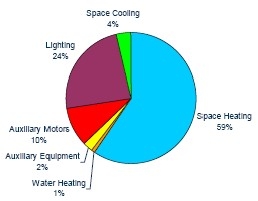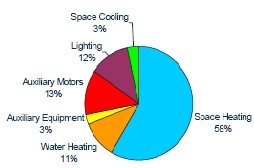Solar Energy; Not Just Electricity
A common inaccuracy that I frequently encounter - through work, in the media, and in government - is based on an implied assumption that energy, and energy displacement, and therefore solar energy, revolves solely around electricity.
What is missing here is the heating component. It is a statistical fact that in heating climates, buildings usually use significantly more energy for heating purposes than for electricity. In other words, the 40% of CO2 emissions that originate from the building sector represents the sum of two types of energy usage — electricity and thermal — not just electricity.
Now, this statement may seem obvious and rudimentary, but reflect on how often the "renewable generation of electricity" completely dominates the energy discussion, while overlooking the idea of "renewable generation of heat." The result is policy recommendations that are at best, only half complete because they are missing a large part of the problem, as well as an opportunity for cost effective energy and CO2 displacement
In the southern states, it is true that a majority of energy consumption originates from air conditioning and electricity. But in the mid to northern latitude states, a significant proportion of the CO2 emissions from the building sector arise as a result of heating buildings. Heating ventilation air and general space heating in the spring, winter and fall, as well as water heating throughout the year, usually accounts for upwards of 60% or more of a building's energy usage and corresponding CO2 emissions. And it is this heating component that is so often overlooked.
Consider the following example. I was recently reading a report in which PricewaterhouseCoopers calculated that in the city of Toronto — which has 4000 heating degree days, and is therefore comparable to cities like Minneapolis, Detroit or Chicago — 60% of the energy used in commercial buildings was for heating, while 40% was used for electricity. The proportions were similar for all the other types of buildings examined, and I include the graphs below.


Energy End Use: Commercial
Retail Energy End Use: Healthcare

So, given that commercial, industrial, and institutional buildings in heating climates use significantly more energy for heating purposes than electricity, if the goal of governments is to reduce the CO2 emissions originating from the building sector — which of course it must be — the reader can automatically see wherein the problem lies with having a one-track focus on electricity reduction.
Now in areas where there are electricity shortages, it is understandable why generating clean electricity from renewable sources is such an important consideration. However, the point that must be made is that for any energy strategy to be successful in achieving maximum CO2 reductions, it must include incentives and specific policy directives aimed at spearheading the solar thermal industry as well, not just photovoltaics (PV).
This would also serve the very important economic objective of helping domestic businesses improve their overall competitiveness by stabilizing the volatile energy component of their operating costs. When you consider that the price of natural gas on the New York Mercantile Exchange now sits at US $10 per thousand cubic feet — double what it was only a year ago — it clearly highlights a very strong business case for technologies that displace natural gas or heating oil. And since solar thermal systems (air and water heating) can fit into an acceptable corporate payback period, the potential uptake in solar thermal over the next few years is enormous. The basic fact is that these technologies present a very compelling business case, from both a cost reduction and CO2 displacement perspective.
For these reasons, the European Union has announced explicit "Green Heat" targets as part of their overall mandate to generate 20% of all energy from renewable sources by 2020. France specifically identified solar thermal targets as being necessary to achieving their required CO2 reductions. Given that Europe has always been a world leader in terms of solar policy and deployment, we are hopeful similar objectives will be duplicated in North America - for the benefit of the environment, as well as energy and economic sustainability.
Victoria Hollick is the VP of Operations at Conserval Engineering, which has been instrumental in promoting solar air heating around the world for the commercial & industrial sector with the SolarWall transpired collector. Victoria has had a life-long interest in solar, and became further interested in effecting environmental and renewable energy policy while completing a graduate degree in economics. She is also the Vice President of the Canadian Solar Industries Association.
The information and views expressed in this article are those of the author and not necessarily those of RenewableEnergyWorld.com or the companies that advertise on its Web site and other publications.
 To subscribe or visit go to:
http://www.renewableenergyaccess.com
To subscribe or visit go to:
http://www.renewableenergyaccess.com